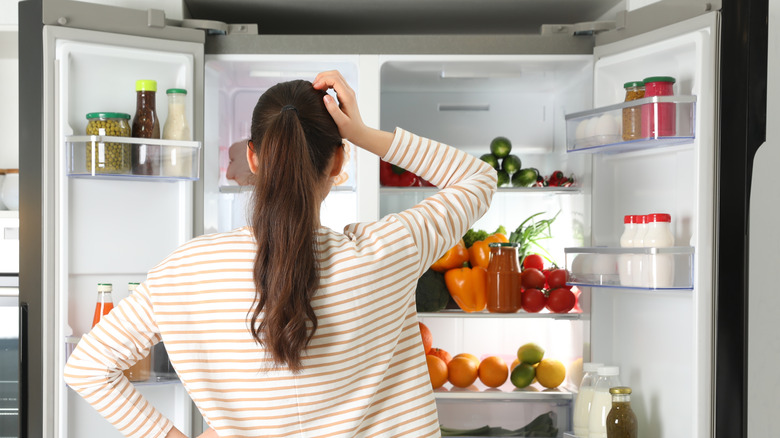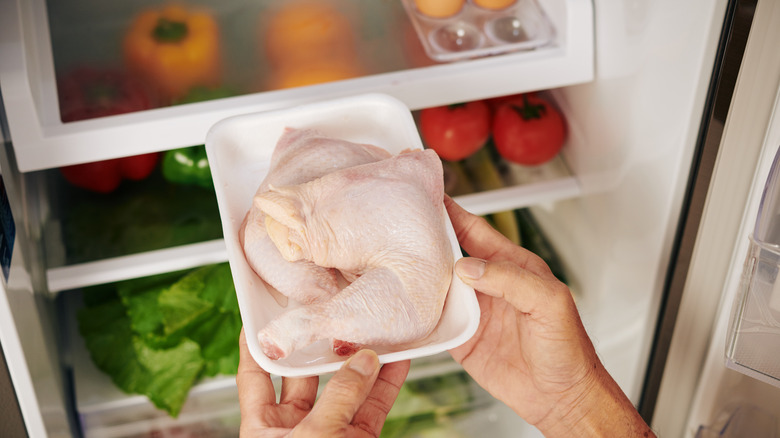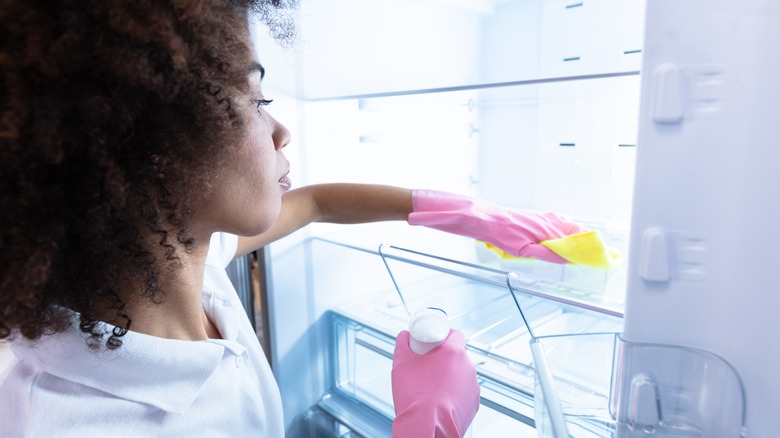Why You Should Never Store Meat On The Top Shelf Of Your Refrigerator
The shelves and drawers in a fridge aren't created equally. Today explains that each spot in a fridge has a micro-climate that's best for certain foods. The door is the warmest spot in the fridge, making it a bad spot for eggs, despite the egg storage that's a common feature in many fridge doors. Ideally, the door will only hold condiments and pasteurized juices.
The bottom shelf, meanwhile, is the coldest. This is the best spot for eggs, even if this shelf is prone to fluctuations as the door opens. The top shelf stays at a steadier temperature, making it good for ready-to-eat foods and dairy products. As for the crisper drawers, they should be set the "moist" setting if that's variable; that will keep fruits and vegetables from drying out. In a perfect world, there would be two of these crispers to help you save money by not tossing veggies prematurely. Some fruit emits ethylene gas, which can encourage vegetables to spoil more quickly; it's best to keep them separated.
It also helps to know what shouldn't go into the fridge. That list includes bread, potatoes, tomatoes, bananas, and avocados. Unripened stone fruits, such as plums, cherries, and nectarines, should also stay out of the fridge.
The refrigerator totem pole
Why is how you organize your fridge so important? Well, you can get sick if things go awry in a fridge. For example, Consumer Reports notes a case where dozens of coworkers were infected with a potentially deadly bacteria. They'd all had chicken tenders, but this form of e. coli wasn't usually associated with poultry. The inspection showed that the chicken had become contaminated with juices from undercooked beef that was kept on the shelf above the tenders.
To avoid these situations, State Food Safety maps out the safest order to stack our fridge, from top to bottom. Foods that require the most cooking (the ones with the highest minimum safe temperatures) should be on the bottom. That includes all raw meat, seafood, and precooked food, including leftover hot dishes. (Those leftovers need to be reheated to 165 F, per the USDA.)
Consumer Reports adds that because they're sharing a shelf, raw meats need to be stored in sealed containers. Clean up any juice spills immediately to prevent cross-contamination.
What's the right temperature?
Having fresh food stacked in the correct order won't do any good if your fridge isn't set to the correct temperature. Typically, 40 F is the standard recommendation. But Consumer Reports found that colder is better and suggests keeping your fridge at 37 F. This is as cold as possible without the risk of freezing delicate produce, such as fresh greens. If your fridge doesn't have a digital thermostat (older fridges might have settings between numbers one and five, for instance), you can always get a fridge thermometer.
Aside from keeping your fridge temperature the right setting, having a clean fridge will help it perform optimally for as long as possible. Cleaning your refrigerator is simple enough but there are a few other things to consider. Consumer Reports suggests vacuuming the condenser coils, keeping the door gaskets clean, and, not stacking items on top of the fridge. This can deter the fridge's ability to offload the heat it creates.


